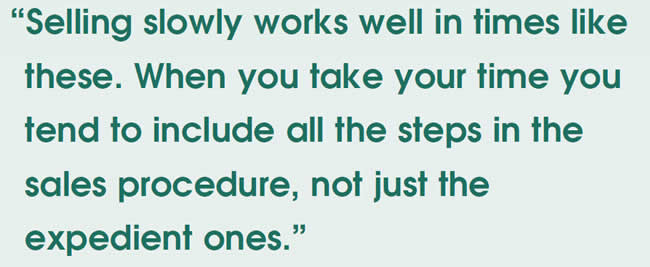
It’s Your Business
- Subject: Don’t hurry the sales process
- Essential Reading: Shop Owner, Center Manager
- Author: Terry Greenhut, Transmission Digest Business Editor
If selling a rebuilt transmission or any other major repair were a race to see who could do it the quickest and probably for the least money, there would be lots of competition. Given the opportunity many of the owners, managers and service advisers in our business would shortcut the process to as few words as humanly possible, stated as quickly as their mouths can move. There may be several reasons why they are in such a hurry, but what they don’t realize is how much money this “need for speed” is costing them.
We are going through a time when consumers are wary, frightened, guarded and downright difficult. People tend to get that way when all they hear every day is the gloom and doom with which the media flood the airwaves – who just cheated whom out of what, and how many just lost their jobs. Does it mean we can’t do business? No; in fact, if we’re smart we can do more and better business than we have in the past several years of so-called prosperity when it seemed that everyone other than us was making all the money. If there is such a thing as taking a turn in business, right now is our turn. Consumers again want, or shall we say “need,” what we have to offer, because they never really wanted it. That need will grow as the recession lingers.

What it all means to us is that although there will be more potential business out there we will have to work harder than ever to get it, especially at profitable prices. Even though our industry has thinned out a bit over the past several years with the weaker and unprofitable shops falling by the wayside, there are still many who believe they can sell cheap and somehow still make money (or at least they keep trying). Add to that the new players in the business: new-car dealers who just woke up and realized that they have repair shops attached to their showrooms. For many years they thought the garage was a place to “make ready” new cars or take care of the occasional warranty issue, but now that they’ve all but stopped selling new cars, they want to try their hand at selling and performing retail repairs. They must be in a race, too, because all they seem to want to do is see how quickly they can shoot a price and get off the phone. The difference is that they do it because they don’t know how to do it any differently or better.
Fortunately for those of you in the aftermarket, dealership service advisers, on the whole, have had far less training in the fine art of selling than you have. They are great at giving “take it or leave it” prices over the phone, though. To prove it just call any one of them, pretend you’re a retail customer and ask for a price quote. The odds are you’ll get one and little else. What is helpful to you, though, is that they generally don’t low-ball as many of your aftermarket competitors would. They tell the caller the actual price of a transmission or other major part. They may leave out the cost of installation, fluid, diagnosis and sales tax, but with a couple more questions a consumer can get the entire picture.
The customer isn’t being done any favor by receiving the price so easily. What he or she is being told is that even though nobody has looked at the vehicle they are willing to quote a price, confirming the customer’s suspicion that the repair is necessary even if, in fact, it isn’t. Of course, many aftermarket shops would handle it in a similar manner, greatly reducing their chance of making the sale as well.
Why are their chances reduced? Because customers don’t ever want to believe they need a major repair. They want to think they might be able to get away with something minor. If you quote a sight-unseen price you cut out almost the entire selling procedure along with the hope of their being able to save any money – leaving the customer with nothing more to look at than an unsubstantiated price. So if they can get a price from you, and so many others, they are likely to base their buying decision on the only thing they’ve heard: the price. If they do that, even though they might be buying the repair at the lowest possible price, they may be buying repairs they don’t even need.

Selling slowly works well in times like these. When you take your time you tend to include all the steps in the sales procedure, not just the expedient ones. It gives you a chance to make your case for the customer bringing the vehicle in for diagnosis before receiving a price, for having a conversation that allows you to get the answers to the all-important qualifying questions, for taking the vehicle on a proper road test and hooking up any diagnostic equipment, and for any lift check or teardown process necessary to determine the proper price of the repair.
Today’s customers, being more skeptical than ever because of the barrage of Internet and media information to which they are exposed, need to see more proof of what they are told they need. The old transmission-shop technique of making a bench sale by inviting the customer to the shop to see the component torn down with the good parts on one side of the bench and the ones that need replacement on the other side is again a viable, though quite time-consuming, alternative.
The act of inviting the customer in to see the worn and damaged parts, in itself, can make the sale even if they never actually come in to look. It projects your honesty and willingness to cooperate. Many times you’ll get the OK right after making the offer.
Don’t underestimate the value of a referral. Nothing lends credibility or makes your price easier to justify than a glowing recommendation from someone the customer already trusts. It could be a friend or neighbor who has used your service or a garage they’ve trusted for their other repairs. In any event these referrals need to be cultivated. That takes time. You must ask every customer, up front, specifically how they came to you. When you find out it was a referral, get the specifics so you can be sure to show your appreciation to the referring party. That’s how you get more of them.
If the customer objects to your price you can always ask, “What did your friend tell you about us?”
They’ll probably say something like, “That you are the best.”
That’s your perfect opportunity to say, “We are, because we use only the best parts and equipment and employ well-trained technicians who keep up with all the latest innovations. Your friend wanted you to have the best. If he wanted you to have the cheapest I’m sure he would have sent you somewhere else. I can have your car done by the end of the day, or would tomorrow be more convenient for you to pick it up?”
Be sure to ask existing customers for referrals to others. Be specific when you ask. Say something like: “Mr. Johnson, thank you for mentioning how happy you are with our service. That’s very important to us. Just offhand, can you think of any family members, friends or co-workers who might have recently mentioned that they are having a problem with their car or aren’t happy with their present service provider?” If they do give you a name, ask, “Would you mind if I contact that person to offer my services?”
Of course, that would involve their either giving you the prospect’s phone number or making the call right from your office so they can introduce you. Some customers will shy away from giving out phone numbers and some will be too busy to take the time to make the call, but as with anything else a percentage of them will want to help you because they truly believe in you. Anytime you can get a referral this way it’s a bonus, one you wouldn’t have had any other way.
If you are able to get a prospect’s name and phone number it’s time for you to do what scares salespeople most: Make the cold call. Dial the number, and when you get the person say: “Mr. Smith, my name is Terry with Joe Blow’s Transmission and Auto Care. A good customer of mine and friend of yours, Steve Johnson, whose car we recently repaired, mentioned that you were having a problem and asked me to call to offer you my services. If it hasn’t yet been resolved I’d be more than happy to take a look. It won’t cost you anything for a preliminary check, and we can do it while you wait. May I set up an appointment for you? What’s more convenient, this afternoon at 3 or tomorrow morning at 8?”
That’s about as proactive as you can get with a referral. Although it may scare some of you to do it that way, it will work in many instances if you are willing to devote the time and energy to it.
Take your time with every step in the sales procedure. Make sure customers understand what they need and why. Build up their confidence in you by being able to prove everything you say if you are challenged. Itemize your repair orders to justify every part and labor operation they need. Your goal is to make them like but most of all trust you. Do everything you can to make it as easy and painless as possible for them to do business with you and they probably will.

Visit www.TerryGreenhut.com.













